This may well end up being my longest post, but hopefully it will be worth looking at. Much of the work presented here is building off of what bh has done. I will get into detail about that as I go.
MethodologyFirst of all, I looked at the animations/videos bh posted closely and took images at key points. bh put numbers in the top right to align things and for lack of a better term I will call these Transition Frame Number or TFN (note these are not the same as DK gameplay frames in the slightest).
The following are the TFN's I took images of and why I thought they would be most useful:
TFN 28: The arcade scan line has just completed a left to right pass and MAME just performed an output of VRAM at TFN 19 and won't do another until TFN 54. Thus 28 is a good point to grab the output values for comparison as we are likely to see aspects of this output in transition analysis.
TFN 60: As previously mentioned MAME output its VRAM at TFN 54 and TFN 60 marks the completion of another Arcade left to right pass.
TFN 93: Arcade completes a scan at TFN 92 but MAME performs an output on 92 (which covers the VRAM output) so I took the image at 93. I later decided to not bother analyzing the VRAM so 92 probably would work, but there is no difference between the two since this was the final arcade pass for these animations.
With these frames decided upon I created an image comprised of two rows. The top row would have Arcade output for the three TFN panels described above in ascending order from left to right and the bottom row would be the same for MAME output. With those images in hand I was able to then split the Arcade and MAME rows into images, align them, and perform a difference on them using a logical pixel by pixel difference check performed by
diffchecker.com's Image Diff functionality. This provided the output for the diff images which show bright pink pixels where differences exists between the two images.
Using the diff output as a guide my methodology was to locate points of difference and then re-examine the animations bh created to understand how these differences arise. Understanding how the differences arise is extremely important as it can indicate whether such differences are likely or unlikely to present themselves in live output of Arcade or MAME gameplay. Importantly, we can also line up this method to see if other known transition differences emerge from the analysis as expected.
Evidence ExaminedBarrel Stage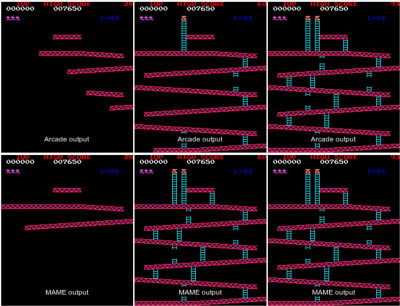
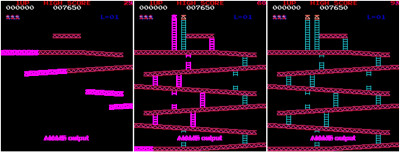 1st Panel
1st Panel: Classic 3 vs 5 girder transition difference is clearly visible.
2nd Panel: This panel indicates that with the exception of the ladders on the bottom girder if we see a capture that shows only the three ladders on the right side of the screen that this is indicative of an Arcade transition that should not be possible in MAME. By the time MAME outputs VRAM for a 2nd time all of the ladders have been drawn into VRAM, but for Arcade the bottom left ladder is only just drawn underneath the scan line at TFN 42. In live hardware I would not be surprised to see arcade play with and/or without this ladder but this analysis indicates we should expect it. You can see an example of this from
Wes at 4:22 but notice we get an extra ladder on the left side one girder up. I think this demonstrates that this analysis does have some limitation and that verification is necessary. To continue the point however this extra ladder is not always there as seen in the same video by wes at 9:02. But more to the point, this extra ladder and a friend appear to tag along in
Billy's 1.04m video at 0:13 and 3:53 (literally the first two barrel transitions in the video). So the point is that while the exact order of rendering may not be perfect, the analysis of the evidence is still revealing clear differences with strong connections to the animations bh has created.
3rd Panel: No appreciable difference.
Annotations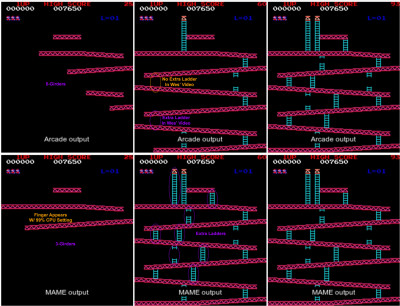 Barrel Stage Empirical Evidence
Barrel Stage Empirical Evidence| Wes 4:22 | Wes 9:02 |
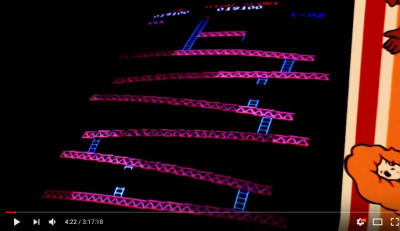 | 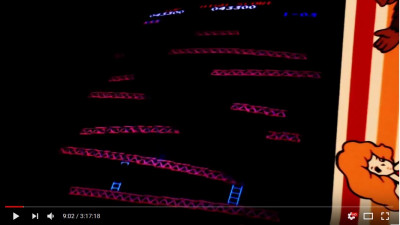 |
| Billy 0:13 | Billy 3:53 |
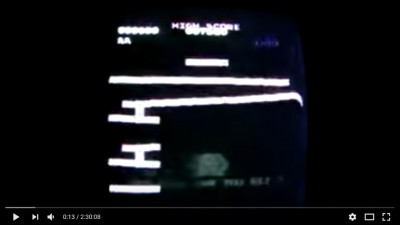 | 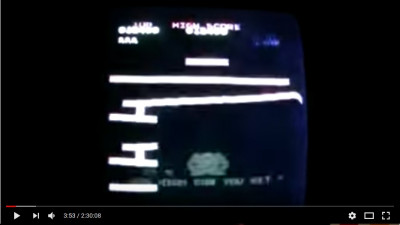 |
Pie/Factory Stage
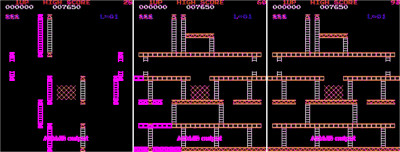 1st Panel
1st Panel: This is perhaps one of the more telling panels in the entire analysis. In the arcade we expect to see these two ladders on the right, and for MAME we expect to see this one ladder on the left. You can see that here with
Billy (left ladder) at 9:38 and Here with
Wes (right ladders) at 25:50.
2nd Panel: The primary differences here are the girders in the lower left have yet to be drawn Arcade but they have in MAME. This difference however cannot help us identify MAME gameplay, but ONLY arcade gameplay because these missing girders will appear in Arcade but in MAME we won't know if they are drawn because we are on this panel or the next panel where both MAME and arcade display the girders. Here is an example of this from
Wes' video you can see it faintly at 11:33 and 17:40 but the best example is the 25:50 transition mentioned in the 1st panel. In this example we catch the DK Cab frames (the diagonal transition line), thus we can see this Arcade transition for the 2nd Panel as well as the arcade transition for the 1st panel all in one shot.
3rd Panel: No appreciable difference.
Annotations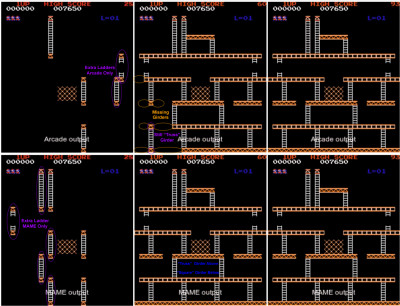 Pie/Factory Stage Empirical Evidence
Pie/Factory Stage Empirical Evidence| Billy 9:38 | Wes 25:50 |
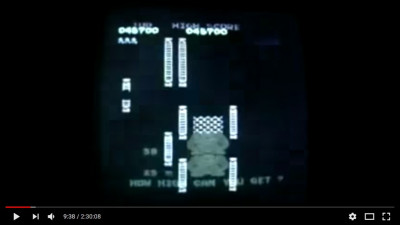 | 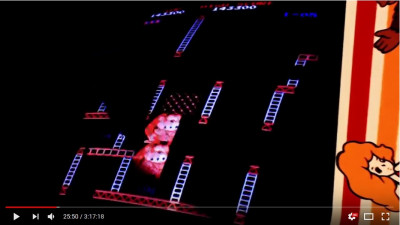 |
| Wes 11:33 | Wes 17:40 |
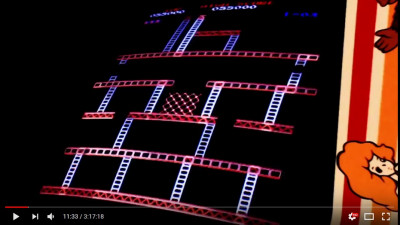 | 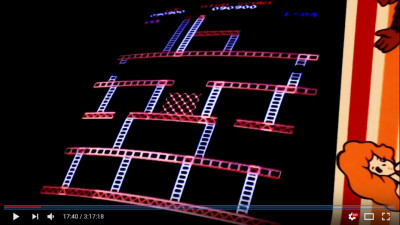 |
Elevator Stage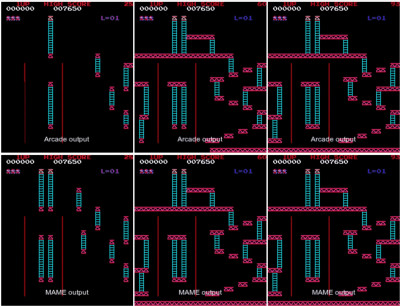
 1st Panel
1st Panel: Here the main differences are the paired ladders show up as a pair in MAME but solo (right side only) in Arcade, but we also see that 4 specific smaller ladders show up on the right side of the screen in arcade but those 4 plus two more central ladders show up in this panel in MAME. At 6:03 in Billy's video you can see double ladders and even though we are mid transition on this frame from "How high can you climb" screen (so we can't tell if we have the 4 or 6 ladders ) we do see we have one of the extra ladders so it looks like this is actually a 5 ladder transition. Another example of how the animations are helpful, but not perfect. More work will be needed to verify that arcade can't produce this 5th ladder without the 6th but the ladder pairs are still quite clear when compared to Wes' video at 48:35 (it was hard to find a clean version of this indicating it may not be a good transition to identify Arcade)
2nd Panel: This is another example of some lower left girders not being fully drawn in on our 2nd panel and again it can only help us identify MAME gameplay because MAME panel 2/3 looks like Arcade Panel 3. Additionally, we can see from Wes' video at 11:56 the bottom girder fading in and that the girder between the bottom of the ladder pair is NOT fading in. This indicates another difference between the animations and yet another reason why comparing to video footage for concrete facts is important.
3rd Panel: No appreciable difference.
Annotations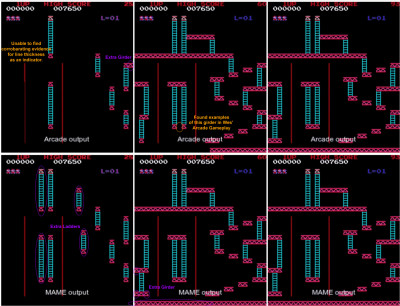 Elevator Stage Empirical Evidence
Elevator Stage Empirical Evidence| Billy 6:03 | |
 | |
| Wes 11:56 | Wes 48:35 |
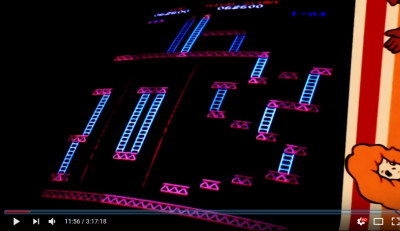 | 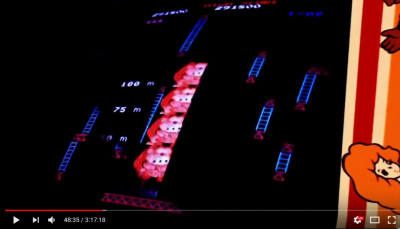 |
Rivet Stage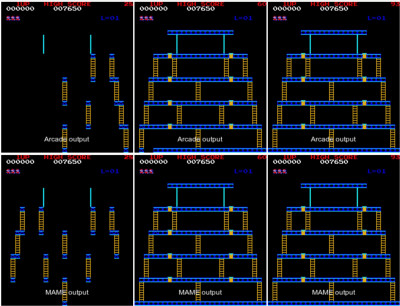
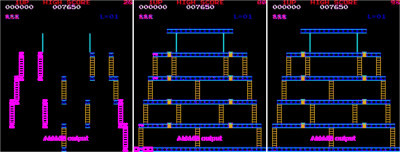 1st Panel
1st Panel: The bottom right two ladders render in arcade in the first panel while the left side ladders do not (see Wes' video at 7:53). For MAME however we see the leftmost three ladders render in the first panel while the bottom right two do not. So in arcade we should never see a transition were the leftmost three ladders are drawn and the right bottom two are not. I couldn't find a good clean example (though the hallmarks/indications are there, it's just not black/white with a clean transition) in Billy's first video so I started looking at the
1.05m video and found this at 3:08. Clear as day we have the left 3 ladders and are missing the bottom right two.
2nd Panel: At first it may appear that the only difference here is that arcade does not render a small piece of the bottom girder, but looking at the diff output highlight that the girder sections drawn WITH the ladders are the barrel stage style "truss girders" while the Rivet stage draws over top of these with the "oval girder" (You may need to click images above and look closely to see, but the visual difference is clear when you know what to look for). Unfortunately, the video quality on the videos I was looking at was not good enough to spot this truss vs oval girder difference, but perhaps the digital original video would reveal it. For now I will leave this as an exercise for someone else to wrap up.
3rd Panel: No appreciable difference.
Annotations Rivet Stage Empirical Evidence
Rivet Stage Empirical Evidence| Wes 7:53 | Billy (1.05m) 3:08 |
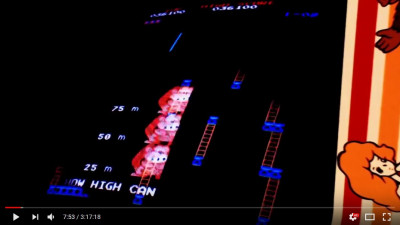 | 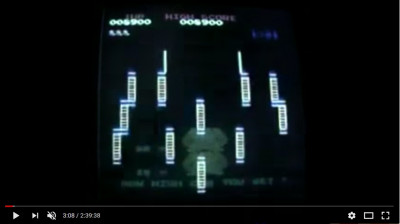 |
If I were to do this again I would exclude the third panels, they produced nothing interesting. Though I suppose it was best to be sure and demonstrating this fact is useful in its own right.
This was just some quick analysis on my part, I know a more thorough examination would likely reveal a lot more examples in Billy's performances but for now I wanted to show my results for the community to reproduce and allow for crowdsourcing any further efforts with my diff images from bh's work.
PS -
I am going to edit this to include images to all of the still examples I pulled from the videos. References to those timestamps will remain for others to verify obviously.
edit: Still image examples have been added. Please let me know if any errors, issues, questions, etc.. are spotted.
edit2: Went to dinner and when I got back decided some annotations might help. I've added them above.






